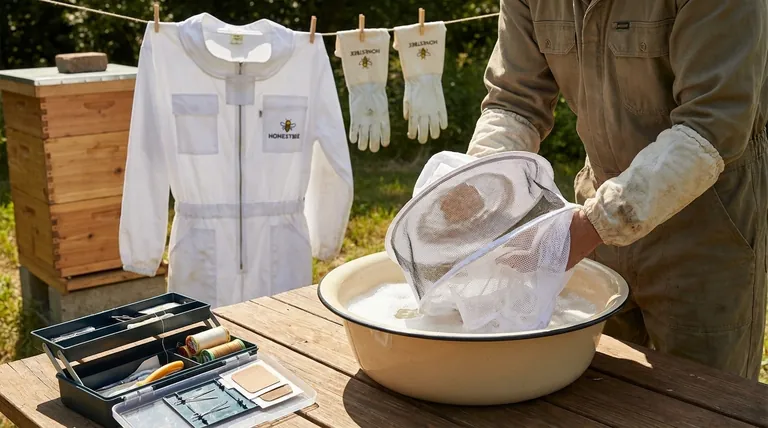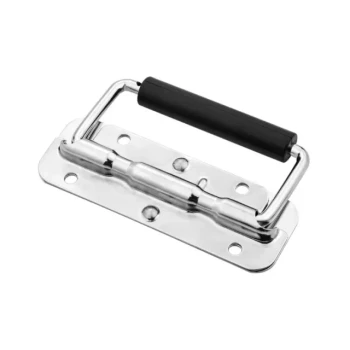To properly maintain beekeeping attire, you should machine wash suits and gloves on a gentle cycle, but hand wash hats and veils to protect the delicate mesh. Always use mild detergents and air dry your gear to prevent shrinkage and fabric damage. Most importantly, consistently inspect all items for holes or tears, especially around seams and zippers, and make immediate repairs.
Your beekeeping suit is your primary line of defense. Its maintenance is not simply about cleanliness, but about ensuring its structural integrity to provide reliable protection from stings. Diligent washing, careful drying, and routine inspection are the three pillars of effective gear maintenance.

The Goal: Preserving Protective Integrity
The purpose of maintaining your gear goes beyond simple hygiene. It's about ensuring the equipment can do its job effectively every time you approach a hive.
Why Cleanliness Is Crucial
Old wax, propolis, and dirt can degrade the fabric of your suit over time. More importantly, a suit that has been stung can retain alarm pheromones, which may provoke more defensive behavior from bees during future inspections.
Preventing Breaches
Bees are experts at finding weak points. A small tear in a seam, a faulty zipper, or a hole in a veil is an open invitation for a sting. Regular maintenance is fundamentally about finding and fixing these vulnerabilities before the bees do.
A Step-by-Step Cleaning Guide
Different components of your attire require slightly different care. Always remove the veil from the suit or jacket before washing.
Suits, Jackets, and Pants
Most cotton or poly-cotton bee suits are machine washable. Use a gentle cycle with cold or warm water and a mild detergent. This prevents unnecessary stress on the fabric and seams.
Veils and Hats
Veils are the most delicate part of your gear. Always hand wash veils and attached hats in a sink with warm, soapy water. Machine washing can easily tear the fine mesh or warp the hat's structure.
Gloves
Fabric or ventilated gloves can typically be machine washed along with your suit. Leather gloves, however, should be wiped clean with a damp cloth to avoid drying out and cracking the material.
The Importance of Air Drying
Never put your beekeeping gear in a machine dryer. The high heat can shrink cotton suits, damage zippers, and melt or weaken the synthetic mesh of your veil. Always hang your gear to air dry, preferably out of direct sunlight to prevent fabric degradation.
Common Maintenance Pitfalls to Avoid
Mistakes in maintenance can be as damaging as neglecting it entirely. Understanding what not to do is critical for extending the life of your gear.
The Problem with Harsh Detergents
Strong detergents and bleach can break down the fibers in your suit, weakening the fabric and making it more susceptible to tears. Stick to gentle, scent-free laundry soaps.
The Risk of Neglecting Inspections
A perfectly clean suit with a small, unnoticed hole offers false security. The single most common mistake is failing to perform a quick but thorough inspection before every use.
Delaying Repairs
A small hole in a seam can quickly become a large tear. Addressing minor issues immediately with a simple needle and thread prevents them from becoming problems that compromise the entire garment.
Making the Right Choice for Longevity
Your maintenance strategy should be driven by the goal of ensuring your gear is always ready and reliable.
- If your primary focus is maximum safety: Your top priority is a pre-use inspection, meticulously checking every seam, zipper, and the veil mesh for any potential breach.
- If your primary focus is equipment longevity: Emphasize gentle, cold-water washing and always air drying to preserve the fabric, zippers, and veil integrity.
Proper maintenance transforms your beekeeping attire from a simple garment into reliable protective armor.
Summary Table:
| Maintenance Step | Key Action | Why It Matters |
|---|---|---|
| Washing | Machine wash suits/gloves (gentle cycle). Hand wash veils. | Removes degrading propolis & alarm pheromones. Protects delicate mesh. |
| Drying | Always air dry; never use a machine dryer. | Prevents shrinkage, fabric damage, and melted veil mesh. |
| Inspection | Check for holes/tears at seams and zippers before every use. | Prevents bee stings by fixing vulnerabilities proactively. |
| Repairs | Make immediate repairs to small holes and tears. | Stops minor issues from becoming major safety compromises. |
Ensure your apiary's safety and efficiency with durable, professional-grade gear from HONESTBEE.
We supply commercial apiaries and beekeeping equipment distributors with wholesale-focused operations, providing the reliable suits, veils, and gloves that form your essential first line of defense. Proper maintenance starts with high-quality equipment built to last.
Contact HONESTBEE today to discuss your wholesale needs and equip your team with gear designed for longevity and maximum protection.
Visual Guide

Related Products
- White Beekeeping Protective Suit and Hat with Fencing Veil for Beekeepers
- Cotton Beekeeping Suit and Round Hat with Veil Bee Keeper Protective Gear
- Economy Polyester Beekeeping Jacket with Veil and Hat
- Beekeeping Jacket with Hood and Veil for Beekeepers
- Heavy Duty Cowboy Beekeeper Hat with Visibility Veil Outdoor Professional Beekeeping Protective Gear
People Also Ask
- Why is white the predominant color in bee suit designs? | Key to Hive Calm & Beekeeper Safety
- What is the recommended maintenance for beekeeping protective clothing? Extend Gear Life & Safety
- What are the benefits of elasticized cuffs and ankles in beekeeping suits? Ensure Total Protection & Comfort
- How should a bee suit be cleaned? Protect Your Investment and Ensure Apiary Safety
- What are the main types of protective clothing worn by beekeepers? Choose the Right Gear for Maximum Safety



















